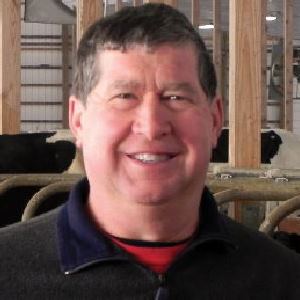Team Approach, Timing and a Little Creativity

 |
Rendell Tullar
Orford, N.H.
Tullando Farm, a cowherd of 550 registered Holsteins in the Connecticut River Valley, is heading toward a robotic milking future.
Getting off to a good start is key in our nutrition and forage program. By using a custom harvester and trucking, we are able to get the job done much faster and improve quality.
We like to hit the ground running with equipment that is ready to go long before the season is here. Having corn planted early so when the grass and alfalfa are ready, we can cut it in the small window we have for high quality and tonnage along with being able to harvest at the optimal dry matter.
Bonus Content | |
| Video from Mark Rodgers |
We try very hard to make high quality haylage in a day. Using a Big M 400, we are able to mow in wide swaths about 90% of the cutting width, which allows for fast dry-down. Using a twin router rake, we can then rake 60’ into swaths for the self-propelled chopper to chop at 35% moisture. We then are able to store it in bunker silos, packing with a John Deere 7930 with a packer on the back to reach a desired density of 16 lb. per square foot.
We cover the pile with black and white plastic and tire-to-tire coverage over that. This has allowed us to have minimal spoilage on the top of our piles. We are going to use a film to cover some of our feed piles this year and see if we can eliminate all waste.
When harvesting corn, we are able to cover 75 acres a day. This has allowed for a much more uniform corn pile at feed-out. Using a kernel processor has allowed for much higher digestion of kernels while being able to put corn in at a dryer dry matter for a better fermentation. We also use our 7930 and packer on the corn along with at least one 7930 John Deere tractor with weights for optimal packing of 20 lb. per square foot.
To help with fermentation, digestibility and feed-out stabilization, we use inoculants on both the haylage and corn silage. Feed-out quality is also preserved by using a forage facer on the front of our loader. We have sized our bunkers for optimal feed-out rates to help maintain quality. We are currently feeding 65% forage rations to our cows with the goal to get to 75% forage and keep a high level of production.
We feed three main groups of cows. It starts with a fresh-cow diet balanced for the first 50 days of lactation. This diet has a little less haylage than the others, but has a pound of straw to help maintain rumen health. We then have a heifer diet for our 2 year olds, which has a little less forage then the mature cow diets. Using a trusted feed company that we have worked with for 14 years and a nutritionist that we have been working with for four years with background experience in the dairy industry has allowed us to formulate diets that meet our needs for milk and components while keeping prices at the lower end of the scale.
With high feed costs over the last few years, we have been very open to finding different sources of ingredients. We have used large square bales of first- and second-cut hay, started feeding brewers grain, are trying a cranberry product, and have fed cookie meal, flour, ground chocolate, canola and bakery waste. We also are able to use many different companies to help find the right price on commodities. During harvest of many ingredients, we are able to book and lock in prices that are much lower than at other times of the year. Not only are we guaranteed a price but supply as well.
Using a team approach to all of our nutrition and forage needs has allowed us flexibility and creativity. Creating diets that are affordable and palatable is always a challenge but one we enjoy trying to achieve.
Tullar’s recent prices
Milk
$25.11 (3.93 bf, 3.03 prt)
Cull cows
$80/cwt.
Springing heifers
$1,600-$2,000/head
Alfalfa hay (milk cow)
N/A
Corn Meal
$210/ton
Soybean Meal
$540/ton
Citrus
$270/ton







